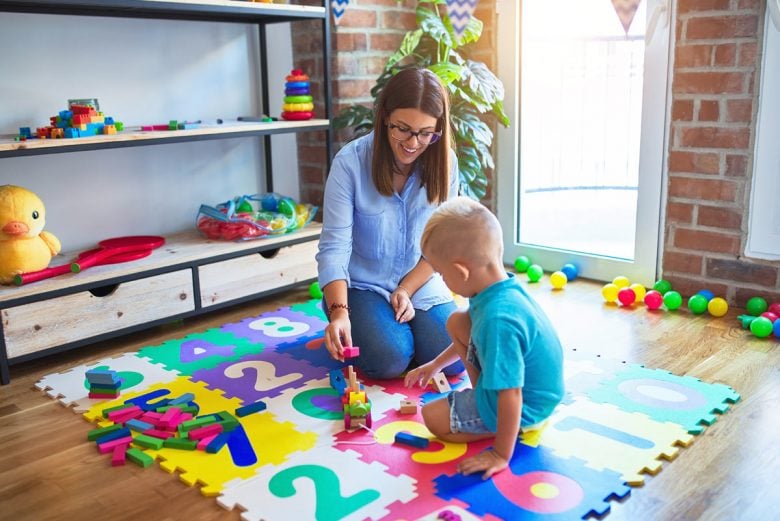
You love them. But do they FEEL it, based on their Type?
You have so much to manage as a parent that sometimes, it’s easy to forget the basics. This episode helps you remember two key things your Type 1 child needs from you in order to feel loved and light.
In this episode, Carol and Anne share two key basics that make parenting easier and your Type 1 child’s life happier.
This Episode’s Parenting Practice
Listen to this episode for the 2 simple tips to brighten your Type 1 child’s experience. Which one can you start doing? Follow the “a-ha” you have while listening to easily create more fun with your Type 1 child.
Transcript of podcast episode
Carol: Welcome to The Child Whisperer Podcast. I’m your host, Carol Tuttle, author of the bestselling parenting book, The Child Whisperer. I’m with my co-host, Anne Tuttle Brown.
We’re getting back to basics today in the child whispering world. Quite often we get so immersed in this content, we forget there are some very simple practices that will reset and support each of your Type of children. Today, we’re talking about the Type 1 child, and, Anne, would you say, if you implement these two things consistently from day to day, it will support your child more than… There’s a handful of little things that if you do consistently, makes a world of difference. They go a long way. And so you just got to keep thinking that way, what are the basics I’m not implementing? So we’re gonna review some basics for you today.
Anne, why don’t you review the primary need and just the general nature of a Type 1 child? Because then when you really come back to that, these parenting techniques are… You’ll know why they work so well.
Anne: Yeah, definitely. So at the beginning of every Type in The Child Whisperer book, you have a header that says Type 1, or whatever Type it is, and then the name that you’ve given the child. So in Type 1, the Fun-loving Child. Then you list primary connection, primary movement, and primary need. These are the basics that you want to remember, and this will be the foundation for everything else that’s shared in the Type 1 section of The Child Whisperer. So primary connection to the world is social, primary movement, bouncy and random, primary need, to have fun and happy parents. And that’s where we’re going to start today is their primary need to have fun and happy parents.
Now, you may be thinking, if you’re not a Type 1 parent, “How do I become a fun and happy parent?” Well, in order to feel loved in the family, Type 1 children, they need to be played with rather than merely told they’re loved. That interaction, that playful quality, will go a long way for Type 1 children.
Carol: That’s true, Anne. And you don’t have to be a Type 1, you can be playful true to your Type. You can be pleasant true to your Type. It’s all about them reading your energy. They want to feel a lightness around you, they want to feel a buoyancy. They don’t want to be dragged down by heavy, structured, just pushy, solemn environments. They just need a sense of playful energy. And that word I want to throw in there, we tend to think, I can see where a Type 4 parent might think, “All right, I have to set up playtime with my child. You know, like 30 minutes a day. I need to be doing pretend play.” Not necessarily, be playful in the everyday moments of the day. Just little spurts of playfulness go a long way.
Anne: What are some examples?
Carol: Well, when you’re making their breakfast, maybe they’re having an egg, make it a smile, put some little blueberries and make a smiley face on it, you see what I’m saying? Just those little touches of animation and playfulness really enamor them. They’re just like, “Aww, that’s so cute.”
Anne: Well, you become a safe place then, where they know that their movement and their need for fun is encouraged and welcomed.
Carol: Right, right.
Anne: I could see even like throughout the day make up silly words or have little inside jokes or a little tickle or something. Like in the Child Whisperer group there was actually a big post and a lot of comments about, “I don’t like pretend play, what do I do?”
Carol: And I would put myself in that category as a mother. I wasn’t effortlessly drawn to pretend playing. So I relate to that. I understand that I’m the, Let’s take them out and go do something, as a Type 3 mom.
Anne: Go do something, yeah. And that’s definitely a form of play. And so I think it’s, see where your strengths lie. But also with the pretend play, we had a comment that I want to share from a Type 4 mom. And she said that her eight-year-old Type 1 makes up the play and she just follows her lead. She says, “I act and talk like myself.” So she’s not, like, feeling like she has to exert a lot of energy to pretend she’s someone else or talk in a silly voice, and she’ll just let her take the lead and tell her what to do. And it works really well. Whereas with her Type 4 son, she follows his lead there, they are playing legos and board games or reading together. So the play may look a little bit different, but just allowing…
And I’ve found that actually, like when I play with my kids, I’m like, “Okay, here I go.” Like, I’ve got to, like, find all this energy within me to play, but if I just, kind of, sit back, and watch, and play, and do as they instruct, and just follow their lead, it’s a lot more…I can relax into it, due to my Type 2 nature, and just, kind of, have fun with it and see where it goes without feeling like I’ve got to become super imaginative or figure out where this is going.
Carol: I kind of match them with their energy. I was very playful with your children the other day, pretending I was a monster. They love being chased.
Anne: Yes, we do a lot of chasing.
Carol: You do have a lot of Type 3 in your family, so you’re like, “We’re chasing you again.” But when I was done, I was done. You know, I’m like, “Okay.”
Anne: Yeah, and I will say, even sometimes, like, “I want to watch you play.” And that could work really well, like show me what you’re doing and just be engaged and watching the pretend play. But, being playful throughout the day, keep that, maybe…
Carol: Touches of playfulness.
Anne: …rather than, like, play, being playful. And that will put such a big smile on their face.
Carol: Even invite their play, join their playfulness as they present it, rather than seeing it as an interference. That’s all it is. It’s just a manner of keeping the energy light, notice that’s the motive behind it.
Anne: And there you have a quick movement and I feel like, “I don’t have time for this right now.” It can often move forward just very quickly if you just engage and open the space for it. And then it can, kind of, just be done.
Carol: Time to take a short break. But don’t worry, we’ll be right back after this.
Announcer: What’s your mom uniform? Yoga pants, jeans and a T-shirt? As a mom, you’re busy. And wardrobe isn’t high on the priority list. But do you ever get tired of feeling blah about how you look? Carol Tuttle’s Dressing Your Truth program helps you create a personal style that works for you, for your budget, for your family, and for your life. You can look more pulled together in less time. All you need is a little know-how. And Carol can show you. Just sign up for a free account at dressingyourtruth.com.
Anne: Let’s move to the primary movement and talk about the next thing that your child needs from you. Back to the basics again, their movement is upward and light, light being the key word here. So when the time comes and you need to have a more serious discussion with your child about maybe some misbehavior that’s going on or maybe something’s happened in the family and certain things need to be discussed, they are better at discussing these serious topics when there is a time limit and an end in sight. And back to their movement being quick, it can often be shortened by about half as what you think. And so keeping that in mind, you know, these Type 1s are playful, light, and fun.
But, you know, like life needs to be talked about and there are certain things, conversations that need to be had that can be heavier. And so they will be able to engage more readily in those conversations when you can even put a timer for yourself, or say, “At the end of this, we can go do this, something lighter,” and they’ll be able to move through that discussion.
Carol: And as they mature and they come to you with some of their problems and their concerns, like even my Type 1 daughter, who’s an adult with her own children, but she’ll come turn to me in times of just needing support. I’ve learned through that, that rather than make it serious, she’s really just wanting someone to help her lighten it up. I’m like, “It’s okay. It’s not that big a deal.”
Anne: I like that perspective.
Carol: Yeah, let them… They need to vent, they need to kind of clear with talking and getting validation. So just rather than getting into it with them and, “Let’s really look at this,” just go, “It’ll probably blow over.” You know, I just need to help her, like, lighten up a little?
Anne: Maybe even laugh about it a bit.
Carol: You know, “You’re okay. It’s fine. It’s not that big a deal.”
Anne: Yeah, I like that insight. So remembering the basics. Primary need, have fun and happy parents. Primary movement, upward and alight.
Carol: And there’s a phrase that each Type really benefits from. You’ll notice that… I’ve seen this for years as I’ve taught the different tendencies of the 4 Types, Type 1s, their go-to word in any form of acknowledgment, agreement, affirmation is fun. That’s so fun. They’ll even… In our Dressing Your Truth space, we’ll see women, you know, if they like a garment, a style…
Anne: “Oh, that’s so fun.”
Carol: …of hair, they’ll say about it, they say, “Ooh, I really like that shirt.” They’ll say, “That’s so fun.” So fun is a reference to…
Anne: It’s a descriptive word.
Carol: …it’s a good thing. It’s a very positive thing in their world. It’s an acknowledgment. So why not use it with them? “You’re such a fun child.” Use the word they use to validate and they feel very honored.
Anne: Yeah, you could even, when they bring home like an assignment from school or a project, “Oh, that’s so fun.”
Carol: “Look, you got an A, that’s so fun.”
Anne: Yeah, which isn’t the first word I would use.
Carol: No, no, I’m like… But that’s their language to affirm their world. And that speaks to them then. These again, are not… You get a parent… We tend to make it harder than it needs to be.
Anne: Sometimes overthinking.
Carol: And it’s like, simple, simple, simple. It’s simple to do these things. And you do these simple practices, you get huge return for them over the years of your relationship with your child.
Anne: Your parenting practice this week is to put this into practice. Which of these can you start doing? What are you not doing? What aha did you have while listening that you can start doing and create more fun with your Type 1 child? Look forward to the rest of the Types’ podcasts coming up.
Carol: Thanks for listening. For more support, go to thechildwhisperer.com where you can purchase the book, subscribe to our weekly parenting practice e-mail, and find a transcription and audio of “The Child Whisperer” podcast.
Anne: If you’re listening on iTunes, thank you for leaving a review. If you have a parenting question, please send it to [email protected].



